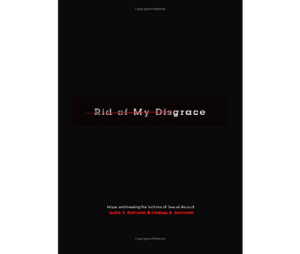Rid of My Disgrace
 Rid of My Disgrace – Hope and Healing of Victims of Sexual Assault
Rid of My Disgrace – Hope and Healing of Victims of Sexual Assault
As a Christian psychotherapist, I found Rid of My Disgrace to be a very well-researched, thorough analysis of the issue of sexual assault from both a clinical and biblical perspective. This is likely a reflection of the co-authors, John Holcomb, a pastor and professor, and his wife Lindsey Holcomb, who has counseled victims of sexual assault and trained leaders to care for them.
They quickly establish a tone that is compassionate, supportive, encouraging and Christ-centered to victims of sexual assault. I appreciated their emphasis on how “God restores, heals, and re-creates through grace” (p. 15) in contrast to secular notions of healing based on self-help, self-healing and self-love.
The book is divided in to three parts. In Part One, titled “Disgrace,” the pair provides a thorough, detailed definition of sexual assault that emphasizes the traumatic nature of such an experience for both female and male victims. They offer facts and statistics that put the epidemic of sexual assault into a sobering, somber perspective. The authors detail potential biological, psychological, social and spiritual injuries that can result from sexual assault. Again, I appreciated that they draw the reader back to God’s ability to heal when they write,
What grace offers to the victim experiencing disgrace is the gift of refuting distortions and faulty thinking and replacing their condemning, counterfactual beliefs with more accurate ones that reflect the truths about God, yourself, and God’s grace-filled response to your disgrace” (p. 45).
In Part Two, titled “Grace Applied,” the pair offer vignettes written by both female and male victims of sexual assault. These testimonies convey emotions and experiences that grab the reader’s attention and empathy. They then write about denial, distorted self-image, shame, guilt, anger, and despair. These are approached from a perspective that seamlessly combines sound clinical information with scriptural references. They do note how forgiveness is different than reconciliation, although I wish they would have expanded upon this even more, as often the two are considered one, which can be a significant hindrance to forgiving. The pair consistently point the reader back to Christ and Scripture as the source for all comfort and healing.
In Part Three, titled “Grace Accomplished,” the authors talk about how sexual assault is the result of sin—against the victim and against God. “In addition to being a sin against others, sexual assault is also a sin against God because the blessing of sexuality is used to destroy instead of build intimacy” (p. 170). They note how sexual assault can change how victims relate to other people, and also how they relate to God. They go on to detail grace in the Old Testament, emphasizing that, “Not only does God hear, God also sees. And out of hearing and seeing, God knows the suffering of people” (p. 180). The authors end with a chapter about grace in the New Testament that focuses on the redeeming work of Christ on the cross. “The work of Christ is to deliver us from suffering, corruption, and death, as well as from sin” (p. 207).
Overall, I found the book to be very informative and thorough. Its strengths seem to be in the details about what sexual assault is and how it can impact victims, along with the need for Christ for complete healing. Pastors and loved ones of victims may find this especially beneficial.
The book may leave some victims wanting more detailed strategies about how to heal, as it is not a workbook with exercises that might help one to apply the knowledge contained in it.
Buy Now
Author: Holcomb, Justin S. & Holcomb, Lindsey A.
288 pages
Reviewed by: Sheryl Cowling, LCSW, BCPCC, BCETS February 2015



